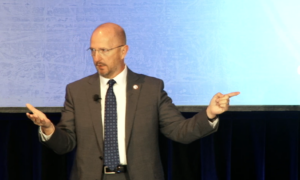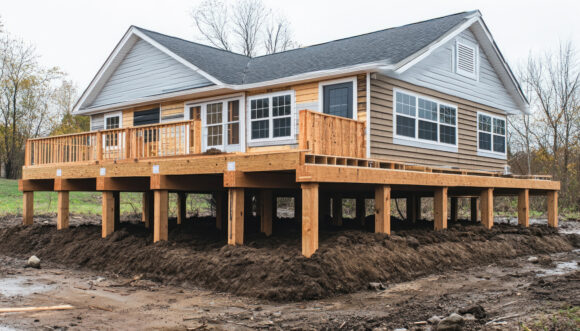At the Florida Chamber of Commerce Insurance Summit last week, the state’s emergency management director announced a multi-million-dollar program that many homeowners, lawmakers and insurers have long hoped for: New grants and low-interest loans that will help elevate homes above flood levels – an action that could reduce insurance claims and litigation as storms and flooding increase in the years to come.
Full details on the new Elevate Florida program have yet to be released. But Kevin Guthrie, executive director of Florida’s Division of Emergency Management, said at the insurance summit that he has worked closely with federal officials to clear the way for some key innovations.
“I want to let you know of some programs that we are going to tie together for the first time in the history of the United States,” Guthrie said. “We are working with our federal counterparts along with the folks here in the state of Florida to do some new things that are going to directly impact homeowners and their insurance rates and their National Flood Insurance.”
The program would work something like this: Homeowners affected by recent hurricane storm surge and floods can already apply for grants to rebuild and elevate their homes above the base flood elevation. But the residents must put up at least 25% of the total estimated grant to qualify. Under the coming arrangement, homeowners – not businesses – would be able to apply for federal Small Business Administration loans – up to $500,000. (No interest for the first year and then perhaps an interest rate of around 2.8%, at today’s rates, Guthrie explained.)

The homeowner can then use the SBA loan to cover the 25% downpayment for the elevation grant. Qualifying for an SBA loan, by the way, often is easier than meeting bank-loan requirements, he argued.
The funding for the mitigation-elevation grants is essentially federal. Some $2 billion in federal disaster relief funds were made available after Hurricanes Debby, Helene and Milton hit Florida this fall. Most of that can be used to assist stricken homeowners, but some of it can also go to elevation and mitigation programs, Guthrie said. A division spokesperson did not provide the funding level that may be available.
Federal agencies also have given the green light to use the Small Business Administration loans to refinance homeowners’ existing mortgages – with terms for up to 30 years, often at much lower interest rates.
“This has never been done before,” Guthrie said. “When we presented this, the mitigation and resiliency guys at FEMA said that no one has thought of that before.”
Guthrie said that the idea for the program came about early this year, when weather models predicted multiple hurricanes this season. The state Division of Emergency Management vowed to prepare for as many as seven storm strikes in 2024. But hundreds of older homes, built before more-recent building codes and elevation requirements took effect, were swamped and thousands more remain in harm’s way, all across the state, he noted.
“As emergency managers, we cannot just respond to disasters,” Guthrie said. “We have to think of the whole economy and do all we can to build a resilient Florida. If we elevate (homes) out of the floodplain and harden them against wind, what will that do for insurance rates for homeowners? Rates will go down, not up.”
A division spokesperson said more information about the program will be available in coming weeks. For now, homeowners affected by the recent storms can check the division’s website or email ResidentialMitigation@em.myflorida.com. Interested homeowners can start preparing by taking photos of their flood-damaged property, showing high-water marks with height measurements clearly visible; making copies of insurance claims information; and tracking receipts or estimates for repairs.
The Elevate Florida program is one of at least three mitigation programs offered by the state. The My Safe Florida Home program provided $200 million for matching grants for inspections and wind-mitigation retrofitting this year. More than 58,700 homes qualified for the funds this year. But the program proved so popular that it ran out of money within months. A pilot program for condominium hardening also ran out of funding quickly.
Some in the insurance industry have said that more extensive mitigation efforts, including elevation programs, are vital to reducing insured losses in Florida as storms increase and sea levels rise. While 2024 hurricanes in Florida have generated as much flooding as wind damage, adjusting and litigation expenses are likely to arise over questions about the nature of the damage.
Flood damage, while sometimes covered by National Flood Insurance or private flood writers, also threatens to give the property insurance industry another black eye: A few national news reports after Hurricanes Helene and Milton have accused Florida property insurers of failing to pay thousands of claims. Many of those claims were the result of floodwaters and were not covered by most homeowner policies, insurers have said.
Of the 309,467 property insurance claims from Hurricane Milton, through Dec. 4, some 7,300 have been closed without payment due to non-covered flood damage, the Florida Office of Insurance Regulation reported. Another 38,000 have been closed without payment because wind damage was found to be below the policies’ deductible level.
Related: Would Letting Roofers Do the Wind Mitigation Help Cut Insured Losses?
Was this article valuable?
Here are more articles you may enjoy.


 State Farm Sued Over Policies Backed by Distressed Insurer PHL
State Farm Sued Over Policies Backed by Distressed Insurer PHL  Verlan Files Subro Suit Against Georgia Chemical Plant After $20M Payout on Fire
Verlan Files Subro Suit Against Georgia Chemical Plant After $20M Payout on Fire  Thailand’s Record Floods Paralyze Key Hubs for Tech and Car Parts
Thailand’s Record Floods Paralyze Key Hubs for Tech and Car Parts  Truckers Who Fail English Tests Get Pulled Off Roads in Trump Crackdown
Truckers Who Fail English Tests Get Pulled Off Roads in Trump Crackdown 